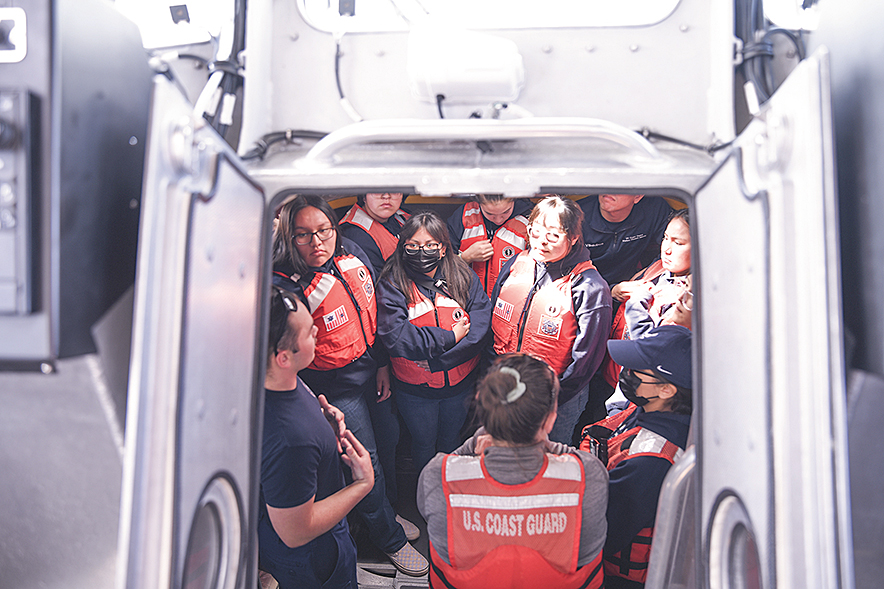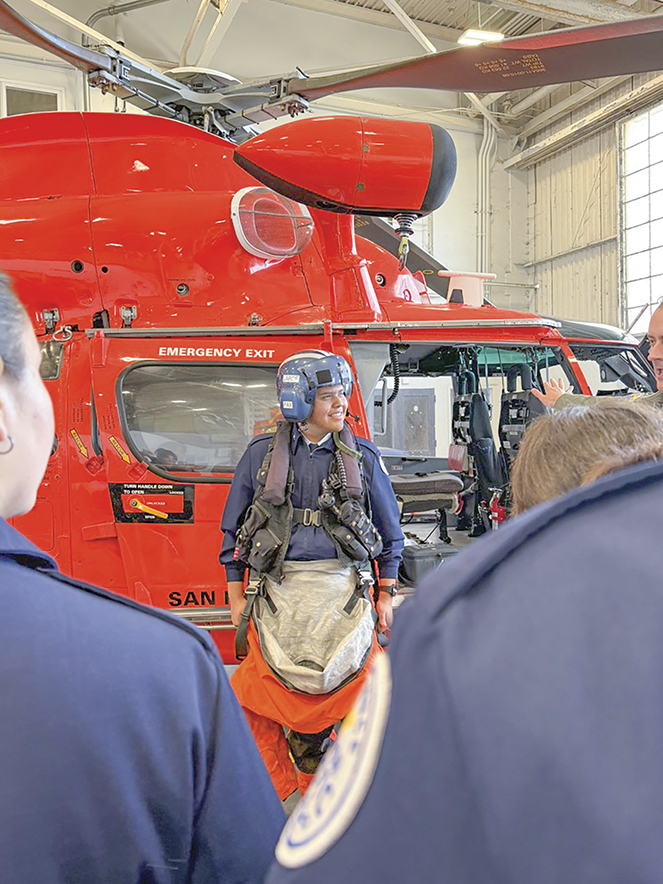‘Mobile hogans’: Coastal trip provides MVHS students with lifetime experience

Special to the Times | Melanie Cissone
Monument Valley High’s (in Kayenta) JROTC members are inside a U.S. Coast Guard vessel at the U.S. Coast Guard Station Channel Islands in Oxnard, Calif.
By Melanie Cissone
Special to the Times
OXNARD, Calif. – Are you ready? Members of the United States Coast Guard are. Always.
After all, the Coasties live by the motto Semper Paratus, meaning “always ready.” So, when Yeoman 2nd Class Corylee J. Redhorse extended an invitation to members of the Monument Valley High School Air Force Jr. ROTC to visit the U.S. Coast Guard Station Channel Islands in Oxnard, the students jumped at the chance.

Special to the Times | Melanie Cissone
Brighton Young seizes an opportunity to try on the jumpsuit and other gear crew members wear aboard search and rescue helicopters while Lt. Cmdr. Ryan McCue talks to the group at the U.S. Coast Guard Station Channel Islands in Oxnard, Calif.
Replete with firsts, the all-Navajo JROTC Oxnard trip, with a dozen students in tow, was preceded by a first-time Coast Guard visit to four Navajo Nation high schools in addition to its seat of government last April.
Chief Petty Officer Jeremy Crawford and Boatswain Mate 2nd Class Danielle Stuteville, both of the Coast Guard Albuquerque recruiting office, joined Redhorse to talk to President Buu Nygren and to JROTC clubs about their lesser considered service branch. While other Native students have visited the Channel Islands Station, never had an all-Navajo group make the trek.
Crawford often shares that the readiness he saw in the helicopter rescue scene from the 1991 film “The Perfect Storm,” based on a true story, inspired him to join. Welcomed warmly a year ago by Nygren in his office, the president gave a shout out a week later to the Coast Guard, a sponsor at the Gathering of Nations Pow Wow.
A nod from the president, stories about joining, and visits in person to the reservation, Redhorse of the Tábąąhá, Naakaii Łizhinii (Nahiłii), and Tótsohnii clans thought, “How could we know whether Navajo high school students might also be motivated to consider the Coast Guard if they knew more about us, had an opportunity to see what we do in person?”
He was right. Nothing could have beat the feeling of chatting with a pilot alongside a multi-million-dollar rescue helicopter, seeing how small the rescue basket is, trying on a crew member’s gear, or watching weather and radar screens while aboard a boat that pounds into oncoming waves.
“It’s tempting to make me wanna join the Coast Guard instead of the Army,” said sophomore Brighton Young about the trip.
‘Developing citizens of character’
Specifically, the invitation was extended to retired Air Force Master Sgt. Jon Sombrero, a 24-year Air Force veteran, who has overseen the JROTC at Monument Valley High School in Kayenta, for six years. While it might seem natural for the airman whose clans are ‘Áshįįhí, Bit’ahnii, Kiis’áanii/Ayahkinii, and Tł’ízíłání to have a bias toward his branch of the service, Sombrero, responded ecumenically. “We always have the Army, Air Force, Navy, and Marine Corps influence due to the proximity of recruiters’ offices,” Sombrero told Redhorse. So, having the Coast Guard perspective and a tour would complete all services.”
Non-existent seven years ago, the school’s JROTC program now numbers 70 cadets, or 11% of the school’s approximate 600 students.
Other JROTC programs at high schools on the Navajo Nation include Shiprock (U.S. Marines), Chinle (U.S. Army), Hopi (U.S. Army), and Piñon (U.S. Air Force). Each unit is “sponsored” by a branch of the service to which it aligns. With half of MVHS students petitioning for the club in 2017, the enthusiastic science teacher believes Bryce Anderson, Ph.D., the Page Unified School District superintendent, decided on an Air Force affiliation because of Sombrero’s experience.
With plenty of structure weekly, including donning their uniforms, Air Force Col. Johnny R. McGonigal, the director of the Air Force JROTC, writes about the program’s essence, “The mission of Air Force Junior ROTC is ‘Developing citizens of character.’”
He continues, “It’s designed to educate and train high school cadets in citizenship, promote community service, instill personal responsibility, character, and self-discipline. Classroom education in air and space fundamentals and hands-on learning opportunities are grounded in the Air Force core values of ‘integrity first, service before self, and excellence in all we do.’”
What does ROTC stand for? It’s the acronym for Reserve Officers’ Training Corps. Junior members are in high school and enrollment is elective. While not obligated to enlist after graduation, cadets who enter any branch of service do so often with both higher pay grades and higher ranks than non-JROTC enlistees.
JROTC operates in 3,500 high schools nationwide, serving a half million students. Critics of the $400 million program, which began in 1916 as the United States entered World War I, suggest it’s predatory, that it grooms teens in low-income populations for future soldiering.
In his 2020 thesis titled Impact of Junior Reserve Officers’ Training Corps on the Quantity of Enlistments, published by the Defense Technical Information Center, John H. Panzer of the Postgraduate School, writes, “According to a Rand study (2017), the JROTC program to this day serves economically disadvantaged schools at a higher proportion. Further, all four sponsoring services consider the school’s Title I status within the criteria for selecting schools to open a new JROTC (Goldman 2017).”
MVHS included, Title I schools receive supplemental federal funding to support low-income families for free or reduced lunches according to the National Center for Education Statistics.
Nonetheless, that same 2017 Rand study indicates that only 20% of JROTC students actually enlist. Further debunking the cadet-to-enlistee case, approximately 40% of cadets are girls – admitted in 1973 – while only 15% of all active-duty forces are female. The most important measure of the value of the junior program to the youth of Kayenta, however, was its petition; demand was there, no coaxing was necessary.
Read the full story in the April 18 edition of the Navajo Times.








 Highway 264,
Highway 264, I-40, WB @ Winslow
I-40, WB @ Winslow